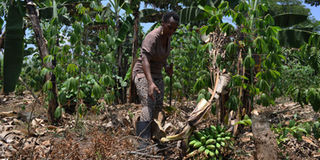Prime
North, east rank low in govt’s agriculture insurance scheme

Harvest. A farmer in her garden. The Uganda Agriculture Insurance Scheme is premised on making agriculture insurance affordable to all farmers in Uganda. FILE PHOTO
What you need to know:
- According to Mr Lubega, agriculture insurance is the magic bullet to the success of farmers since they are increasingly facing several challenges in the wake of climate change.
The government has extended the Agricultural Insurance Scheme Programme for another two years amid a slow absorption by farmers in the northern and eastern regions in the past five years, Monitor has learnt.
Mr Ibrahim Kaddunabbi Lubega, the Insurance Regulatory Authority chief executive officer, in an email to this publication said the programme will run until June 2025.
“The subsidy period was extended to the end of June 2025. We are still engaging on increasing the amounts from the current Shs5b to Shs15b given the increased demand for agriculture insurance,” he said.
According to Mr Lubega, agriculture insurance is the magic bullet to the success of farmers since they are increasingly facing several challenges in the wake of climate change.
On the programme’s performance, Mr Lubega said demand has been exceeding the available subsidy. “According to our records, whereas by December 2017, only 45,704 farmers had taken up cover, the number had grown by March 2018 to 59,146 farmers and 316,496 by December 2022,” he said.
This newspaper also established that the northern and eastern regions are ranked as the worst-performing regions in the uptake and absorption of funds under the insurance scheme.
According to the Economic Policy Research Centre (EPRC) of Makerere University Agricultural Finance Year Book 2022 published two months ago, the north scooped only a 13.2 percent share of the total number of farmers insured under the programme in the five years.
The report indicates that the western region accounts for the highest share (34 percent), followed by eastern and central regions with similar margins (26.3 percent) . However, the western region only accounted for 3.9 percent of the insured subsistence (targeted) farmers, eastern (2.9 percent), central (6 percent) and the north coverage translating to only 2 percent.
According to the document, since 2017, the number of farm businesses insured under the Uganda Agriculture Insurance Scheme (UAIS) increased fourfold, from a meagre 68,361 farmers in the 2017/2018 financial year to 265,049 in the 2021/2022 financial year.
“Considering the share of value insured, the central and western regions account for the largest shares of the value of agriculture insured, about 37 percent and 40 percent, respectively, for both FY2019/2020 and FY 2021/2022, while the eastern and northern regions registered poor performance in terms of value insured.”
This newspaper established that between FY 2019/2020 and FY 2021/2022, the value of crops and livestock insurance grew by an average of 25.6 per cent with the eastern region scoring the highest (over 32 percent) followed by northern region (26.1 percent), while western region registered the least growth (23.9 percent).
The researchers attributed performance in the east and north to massive training and sensitisation campaigns.
The report also observed that a total of Shs15.2b was paid out in claims at the end of the 2020/2021 financial year.
Multi-peril crop insurance accounts for more than half (56 percent) of the total claims, followed by crop weather Index Insurance (32.3 percent) and poultry insurance (7.4 percent).
“Farmers are increasingly embracing crop weather index insurance, while aquaculture (1.2 percent), and livestock (1.7 percent) registered the lowest claims pay-outs since they are the least purchased products due to fewer farmers engaged in them compared to crop farming,” the document revealed.
The researchers highlighted insufficient funding, limited human resources, and inadequate training, among other key gaps that frustrate the programme.
“Due to the increased number of farmers taking up agricultural insurance, the turnaround time for inspection has been affected, with an increased number of inspections being done by a limited number of assessors and loss adjusters,” stated the researches.
Mr Lubega attributed the poor performance in north and eastern regions to unfavourable weather patterns.
“This could be partly explained by their adverse weather conditions compared to other parts of the country that have seen farmers incur huge losses. So they no longer want to shoulder these risks/losses,” he said.
Mr Raymond Orach, a commercial farmer in Gulu District, said the majority of funding insurance went to commercial farmers.
“In Amuru and Nwoya districts, there are commercial farmers who got these funds because their capacity in terms of production guards them against risks of crop failures due to bad weather, pests and diseases, ” Mr Orach said.
He said farmers find it procedurally hectic to chase after the money due to bureaucratic tendencies.
Farmers want better insurance terms, sensitisation
Paulina Chiwangu, UN Women Country presentative: “Funding gaps, especially in the agricultural sector affect women severely, the target interventions do not adequately reach them. The government needs to revise their models in supporting women to engage in meaningful agriculture. Majority of the women farmers are not succeeding due to a hostile environment characterised by inaccessible capital, and limited markets.”
Mr Philip Mulangira, farmer in Lira: “ I have tried this and other loan schemes the government offer to us but the financial institutions in charge of dispensing these funds issue very strict terms and conditions that ordinary farmers, which the government target, would fail to get the subsidy.”
Roselyn Ayat, farmer in Odek, Omoro District: “The leaders do not tell us about these subsidies (insurance). For example, I have never heard about it just like many people in my community. Sensitisation among us the rural population is very key if we have to embrace such programmes.”




